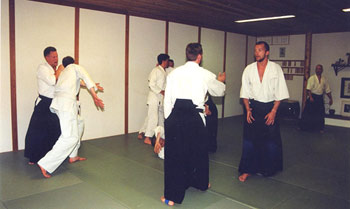|
|
 |
| |
|
About Aikido - Aikido Training: |
|
Aikido is practiced together with a partner in its basic
stages of training. Each person takes turns being the
attacker and defender. This creates a mutual understanding
in practice; learning to receive the technique is just as
much a part of the learning process as it is to learn to
apply the technique in defense.
Aikido does not have competitions. Competition creates a
win/lose situation. In the spirit of Budo, the person who
attacks unprovoked has lost already, morally as well as
physically. Aikido is practiced as a Budo; this means that
we practice together, learning from each other and learning
to control our techniques so that we are able to apply them
so as to never damage or hurt our partner. But by learning
this control we are also able to learn what is necessary if
our techniques must be applied in a self-defense situation.
The training environment in an Aikido dojo is based on the
principle of give and take. The Sempai (senior students)
learn to take care of the Shoshinsha (beginners), just as
they once were taken care of by their sempai when they
began.
|
|
 |
|
In practice, we start with stretching and limbering
movements. Then Ukemi (falling) training is emphasized. In
order to learn to receive the defensive techniques of
Aikido, one learns techniques of falling that enable a more
dynamic application of the techniques.
After Ukemi practice, we move into basic movement practice,
working on moving off the line of attack and positioning
ourselves in well-balanced stances that enable us to apply
our techniques. After basic movement practice, the class
works on one or more of the basic pinning or locking
techniques. This is done in a step by step manner so that
everyone can grasp the different sections of the technique.
Emphasis is later put on practicing the techniques in a more
fluid and dynamic form, but always taking in to
consideration the level of the person you are training with. |
|
|
|
| |
|
|
| |
|
|
| |
|
|
| |
|
|
| |
|
|
|